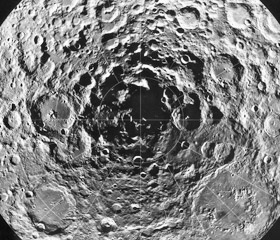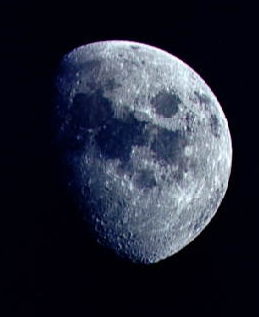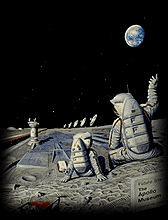Click on image for full size
Image courtesy NASA.
The Moon's Poles
The poles of Earth's Moon are interesting sites due to extremes of sunlight and darkness. Earth is tilted on its axis by 23°, which causes our seasons including the alternating "midnight Sun" and long winter nights near Earth's poles. By contrast, the Moon is tilted only slightly (with respect to the Sun) at an angle of just 1.5°. Lacking seasonal variations in lighting, places near the Moon's poles are perpetually on the edge between daylight and darkness. Places near the Moon's poles that have extreme elevations, such as the heights of mountains and the depths of craters, may be almost permanently illuminated or forever in darkness.
A mountain top that is perpetually bathed in sunlight is called a "Peak of Eternal Light". Scientists aren't sure if any such peaks actually exist on the Moon, but there are several which are at least close. Four peaks along the rim of Peary crater near the North Pole as well as Malapert Mountain and some smaller ridges near the South Pole may be lit nearly all of the time. Such locations are very interesting to space explorers planning trips to the Moon. Solar panels built on top of one of these peaks would be able to supply an almost constant flow of electrical power for robotic explorers or human colonists.
Some deep craters near the poles may be opposites of Peaks of Eternal Light; they might be permanently shrouded in darkness. One of the largest craters in the Solar System, the South Pole-Aitken basin, covers an area that includes the Moon's South Pole. The floor of this crater is 6 km (3.7 miles) lower in some places than the average elevation of the Moon. Permanently darkened crater floors are exceptionally cold and may harbor water ice left over from comet impacts. If such ice actually is found near the Moon's poles, the news will excite scientists and space explorers alike. Ancient ice deposits could provide scientists with clues about the Moon's history. Since water ice can be used for drinking water, to produce breathable oxygen, and to make rocket fuel, explorers are keen to know whether ice can be found at the Moon's poles or not.
NASA's LCROSS mission will attempt to detect signs of ice in craters near the Moon's South Pole. In October 2009 the spacecraft will observe the plume of material kicked up by a controlled crash of a booster rocket stage into a crater near the South Pole.















